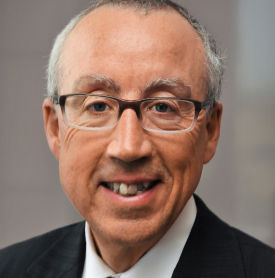The four president and CEOs of Canada’s biggest lifecos discussed the importance of distribution, both in Canada, and abroad at the Scotiabank Financials Summit held in Toronto in early September. Still, it’s generally said that the most promising growth opportunities for these companies don’t come by way of the Canadian market.At the event, in fact, among the four insurers, only Great-West’s Paul Mahon, spoke with any great enthusiasm about the potential for upside growth in Canada. Instead, a focus on Asian economies, expansion in Europe, and work in the United States all appear to rank higher on different company priority lists.
The Scotiabank Financials Summit hosted 30 different financial institution CEOs this fall, who gathered to discuss company efforts, and their plans for the future at the annual gathering. The larger insurance carriers were all represented on day two of the event. In addition to Paul Mahon, Donald Guloien (Manulife Financial Corp.), Dean Connor (Sun Life Financial Inc.), and Yvon Charest (Industrial Alliance Insurance and Financial Services) were all in attendance.
Asia: Who’s in, and who’s out?
Asian markets aren’t talked about with the same unbridled enthusiasm as they have been in the past. Still, a substantial amount of earnings growth is generated in Asian economies for Manulife and, to a lesser degree, for Sun Life Financial. Industrial Alliance annual reports, meanwhile, make no mention of Asian markets, and Mahon, in his presentation, says outright that Great-West prefers to invest in more established markets.
“Unlike many insurers, we choose to invest in developed markets such as Canada, the U.S., the U.K. and Germany. These are well-established markets where we understand the risks, and we believe we can manage the risks effectively,” he says. “Our performance and prospects for growth are not constrained because of our focus; we believe these developed markets bring stronger financial services regulation sound business practices, and generally better access to capital markets.”
The company’s July acquisition of Irish Life Group Limited, with its multichannel distribution, captive distribution channels, independent brokers, pension consultations and a wholly owned brokerage, he says, is much like the company’s operations in Canada.
He says today Canada generates 50 per cent of the company’s earnings, 30 per cent comes from Europe, and 20 per cent of earnings are generated in the United States.
U.S., pension markets, he adds, are experiencing rapid growth; by way of Putnam Investments, the company has a goal to regain a leadership position in the U.S. mutual funds industry, and the U.K. group insurance market remains highly underpenetrated.
Sunlife Financial, on the other hand, is betting that 90 per cent of growth in the financial services industry, in general, will be coming out of Asia in the coming decade. “These markets are almost all early stage growth markets,” Connor says. “I think the estimates I see (suggest) 50 per cent of the growth in the global insurance industry in the next decade will be in Asia.”
That said, although the opportunity is big enough to compete for, Connor breaks with enthusiasm expressed in years past, saying “it’s not a big enough part of Sun Life (today) to be relevant to our investors.”
“We think the Asian business needs to be 15 per cent to 20 per cent of the company so that it becomes more relevant to our investors. That’s our goal. We’ll do that over time through a combination of organic growth and acquisitions.”
Guloien, meanwhile, says approximately one third of Manulife’s core earnings come from Asia today. Moreover, as is more often becoming the case for several carriers domestically, wealth products are becoming an increasingly important part of the products it offers in Asia. As for insurance distribution, he says Manulife has nearly doubled, since 2007, the number of agency representatives it has in the region. “We have something like 55,000 career agents” now, he adds.
Defined contribution plan choices introduced for employees in Hong Kong have boosted the company’s share of that market to 20 per cent, while bank and managing general agency (MGA) relationships continue to drive wealth and insurance sales in other parts of the region.
The cost of acquisition, however, is part of what might be tempering enthusiasm.
“People think of Asia as a high growth place with relatively good margins,” Connor says, adding that company risk is lower for some of the products sold there, relative to the risk undertaken when companies sell product in North America. “That’s all true, but the price of acquisitions reflects all of that. The properties we’ve looked at recently have gone for stratosphere prices.”
India is just as unattractive, he says, particularly given the present uncertainty about ownership rules in the country.
The United States
Internationally, Sun Life is investing in its employee benefits business in the United States, making use of enrolment systems, client building, and disability management systems technology, all developed for use by the company’s Canadian operations.
It continues to focus on developing enrolment tools, and is actively working on transforming the 44 U.S. sales offices, “each with its own way of doing things,” to a new, more unified model, in an effort to scale and grow that line of business.
Sun Life’s high net worth business in Bermuda continues to be a focus for the company, as well, selling insurance and investment products to customers in Latin America, Asia, the Middle East, and parts of Europe – an area of development, Connor says, where there is not a lot of competition.
Finally, he says MFS Investment Management continues to focus on client retention in the U.S., and “more feet on the street” in Europe.
Domestic distribution
MFS is part of Sun Life’s strategy in Canada, as well.
In response to the regulatory need to better match and account for company liabilities, and as an answer to the challenge low interest rates present, several companies have opted to move away from traditional, long-liability insurance offerings, along with their more complex and costly derivatives, such as the guaranteed minimum withdrawal benefits (GMWB) products, to focus instead on their respective wealth management product lineups instead.
“Importantly, this brings the MFS retail funds to Canada,” Connor says. “The only way you can buy MFS retail products in the Canadian market today, is through Sun Life Global Investments.”
Of the four companies, only Industrial Alliance’s Charest discusses the availability of GMWBs, in passing, saying the company slowed sales of the product late last year. IA is another company focused on their mutual fund business, with the CEO telling shareholders the company has outperformed the industry in terms of asset growth, every year since IA entered the market in 2005.
Going forward, he says he would like to expand the company’s retail insurance line to carry product other than those with long-term guarantees. To that end, he says the company is watching closely, after launching its first adjustable premium products in June. “We don’t know how quickly the market will accept that. We don’t know what the reaction will be from the competition,” he says. “But it is certainly a measure we are taking on to better manage our risk.”
At Sun Life, the company has “deliberately deemphasized segregated funds, given their risk and capital characteristics, and emphasised mutual funds and fixed interest products,” says Connor. “We’re expecting a lot more from that segment going forward.”
Group benefits
Group benefits is another area of domestic profitability, albeit one full of stiff competition, that companies are focused on.
Sun Life plans to continue investing in the company’s mobile capabilities, in “wellness” (Connor didn’t elaborate), and in pharmacare management.
More interesting, perhaps, he says in-force business is an area of priority for the company. It is also focused on retaining pension clients when they leave their plans. “It’s calling up plan members as they leave and retire, to make it easy for them to convert their company coverage to a personal policy, right over the phone. Really simple products, easily bought, presented at just the right moment,” he adds.
“When you do that, you create good margins in the business. This is an important part of our future. “
As for Manulife, Guloien says the Canadian group benefits and group retirement markets are driving sales for the company, by way of the cross-selling opportunities these markets create. He says Manulife is now a top-10 mutual fund franchise in Canada. As well, he adds that 41 per cent of the company’s bank products are cross-sold to its existing customers.
In other areas, Manulife recently acquired Benesure Canada Inc. at the beginning of 2013, an administrator and distributor of creditor insurance to mortgage brokers, and entered into an agreement to reinsure RBC’s travel insurance business in August. “It is, in fact, a lucrative and growing business for us.”
Guloien’s next comment about private wealth management might give some a reason to pause: “We’re basically competing with some of you who address the private wealth, high-net worth market. It’s one of the few remaining parts of the asset management business that Manulife does not currently operate in. We’re off to a very successful start.”
Manulife aims to double earnings
While concerns about liquidity, and efficiency have reigned large in recent years, companies appear to have largely worked through these issues.
“For two years we had to do a material increase of reserves,” Charest told the group.” That has not been the case in 2012. We are extremely confident (about) 2013, because we have learned how to manage in the new interest rate environment.”
Thanks to actuarial standards reforms, as well, along with additional hedging of the company’s segregated fund business, he says there should be even less reserve change volatility in the future.
Manulife’s CEO more openly discusses his company’s future prospects, saying it plans to nearly double core earnings to $4-billion, by 2016.
“I think a lot of people assume that expense savings are going to be the major components driving us to this target. That would not be true,” he says. “It’s a significant piece, but it is not the major piece of the puzzle.”
Finally, Sun Life is expecting growth in all lines of business, thanks largely to three “mega-trends,” including the baby boomer population’s coming retirement years, coupled with moves governments and business are taking to download the responsibility for retirement planning to individuals. And the third driver, which is “the really astonishing growth of the middle class in Asia.”
“Those are megatrends,” he says, that “we see persisting for decades.”











